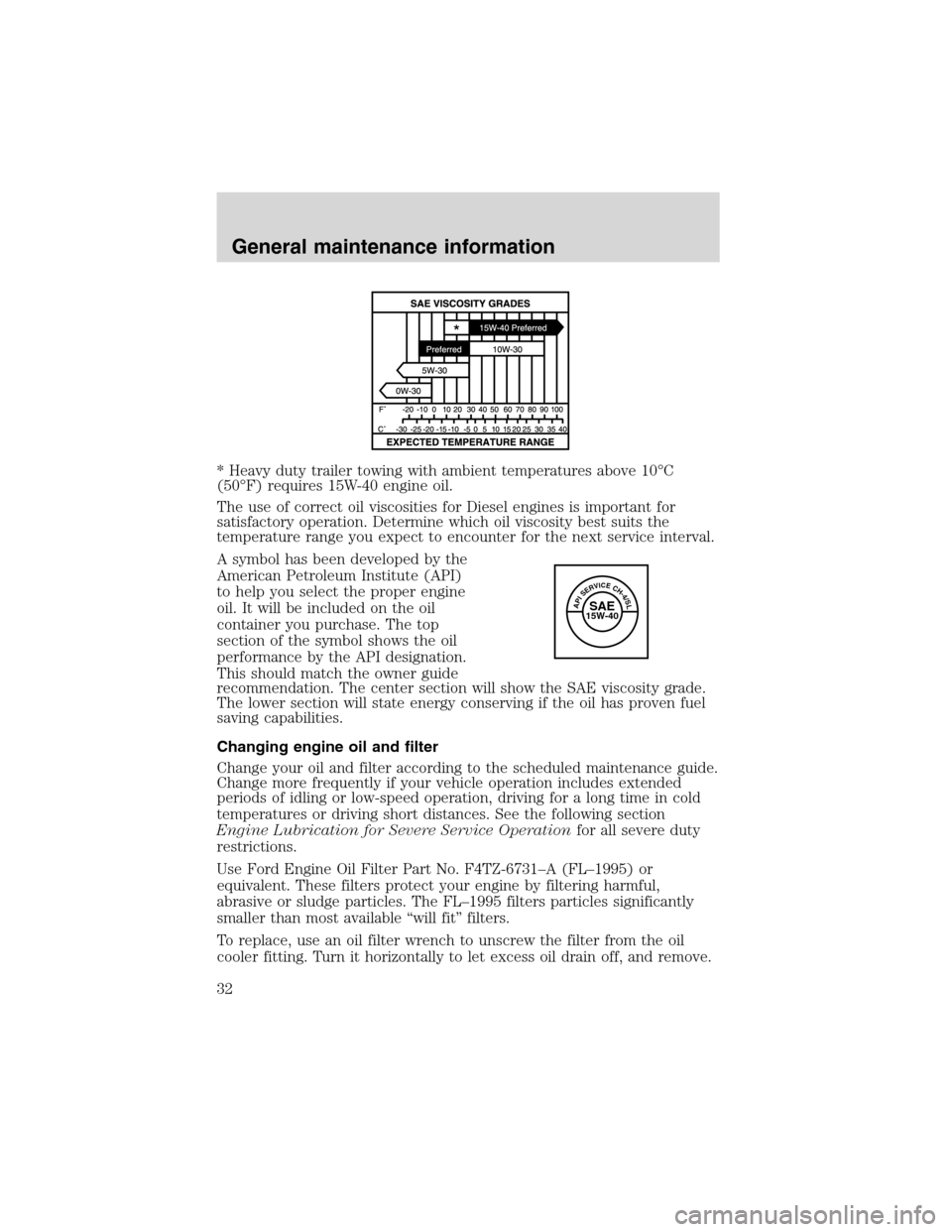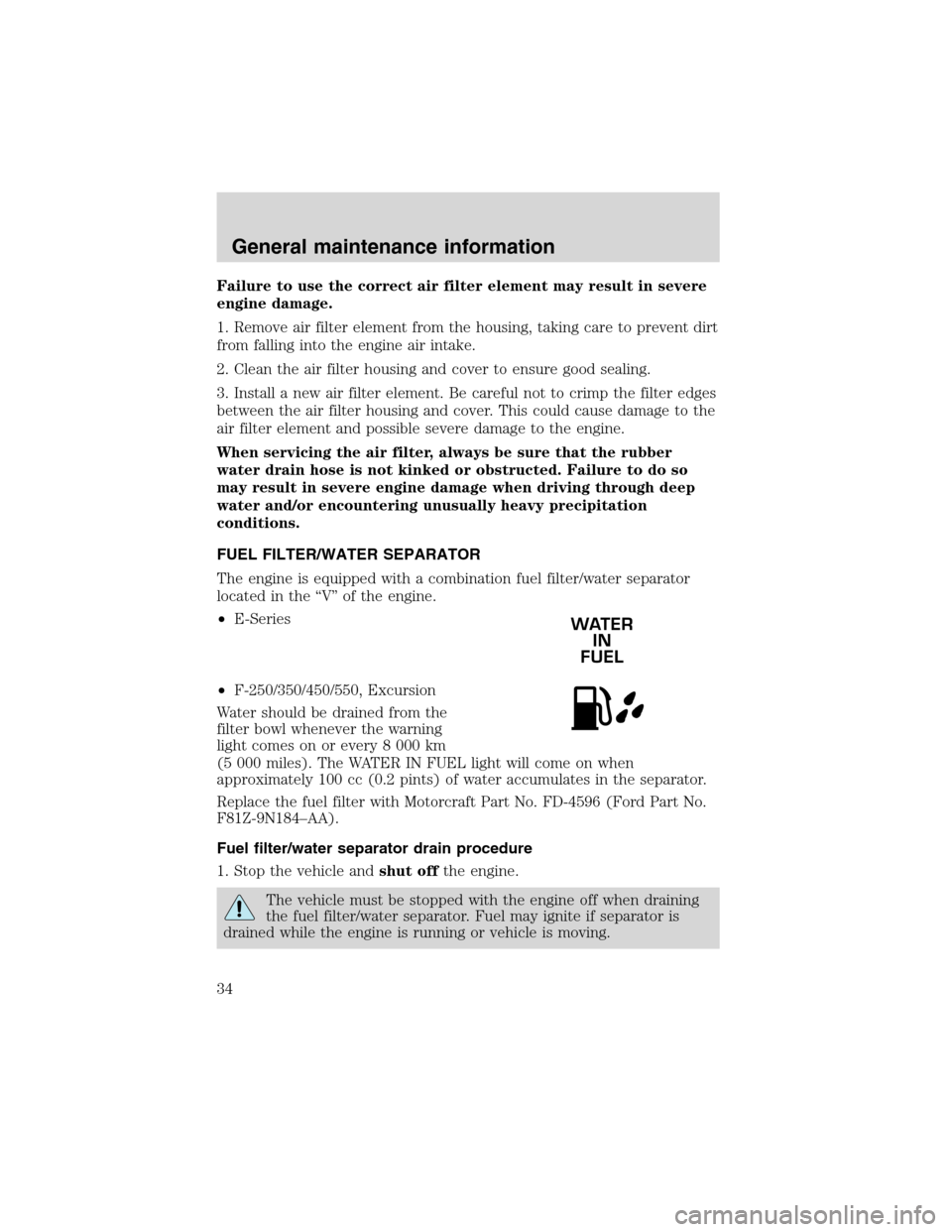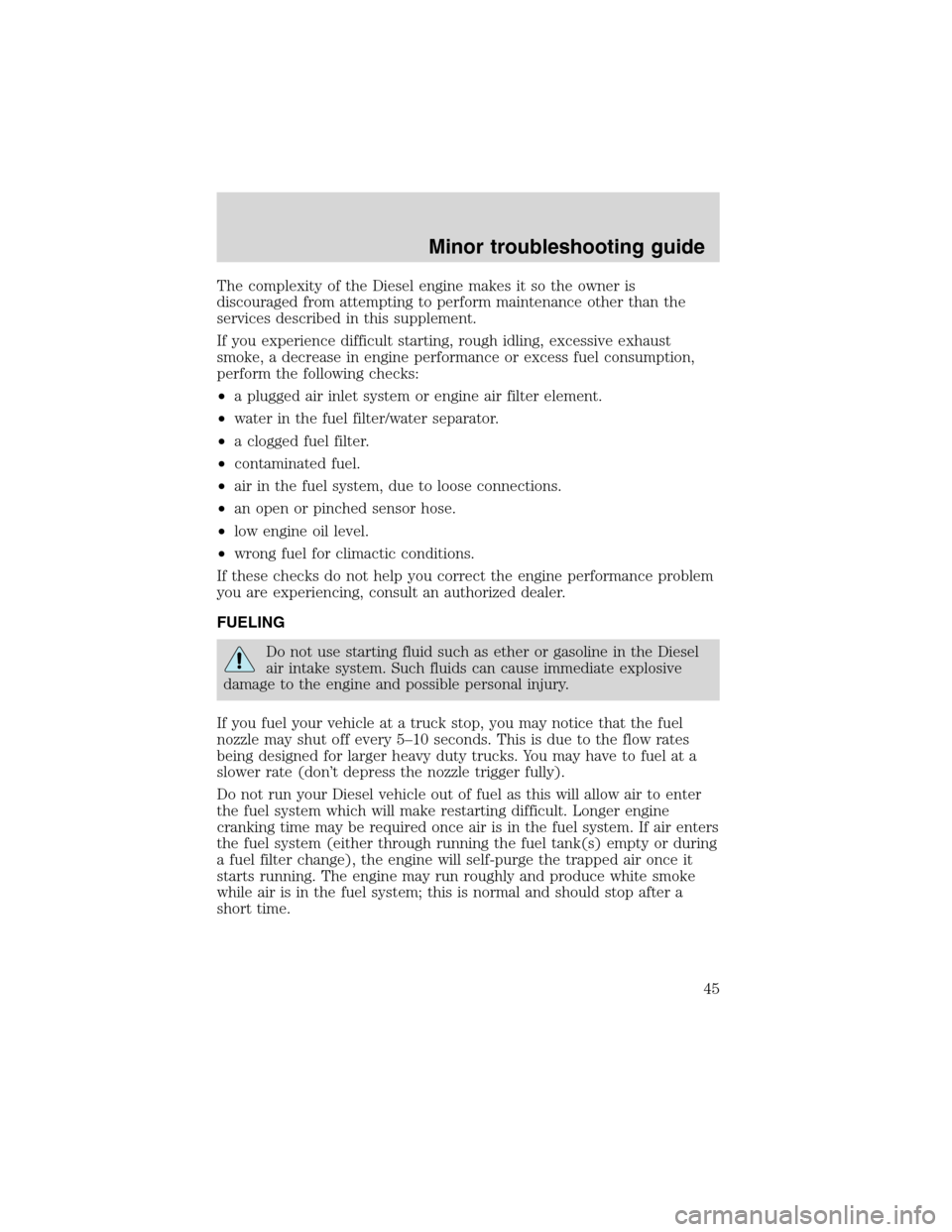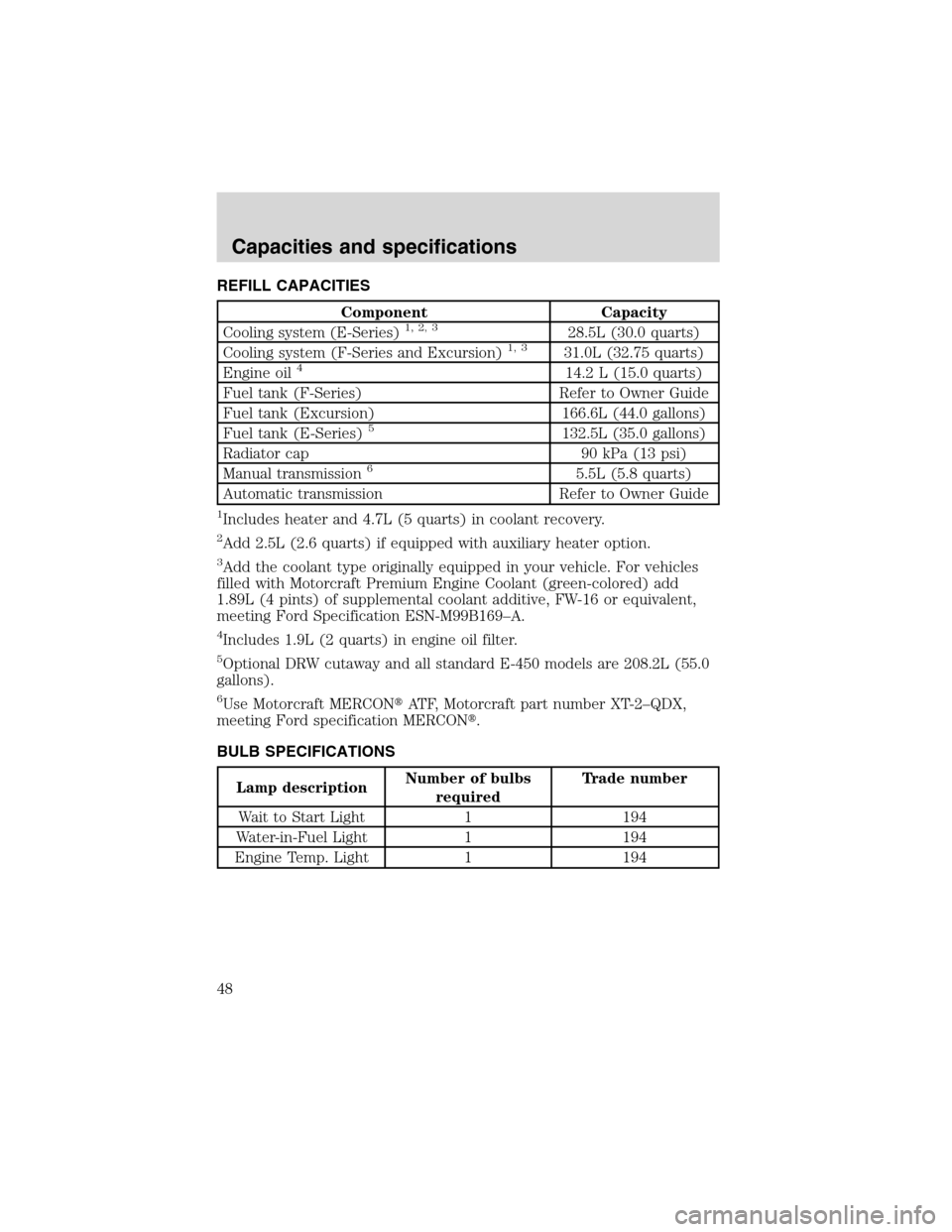Page 32 of 56

* Heavy duty trailer towing with ambient temperatures above 10°C
(50°F) requires 15W-40 engine oil.
The use of correct oil viscosities for Diesel engines is important for
satisfactory operation. Determine which oil viscosity best suits the
temperature range you expect to encounter for the next service interval.
A symbol has been developed by the
American Petroleum Institute (API)
to help you select the proper engine
oil. It will be included on the oil
container you purchase. The top
section of the symbol shows the oil
performance by the API designation.
This should match the owner guide
recommendation. The center section will show the SAE viscosity grade.
The lower section will state energy conserving if the oil has proven fuel
saving capabilities.
Changing engine oil and filter
Change your oil and filter according to the scheduled maintenance guide.
Change more frequently if your vehicle operation includes extended
periods of idling or low-speed operation, driving for a long time in cold
temperatures or driving short distances. See the following section
Engine Lubrication for Severe Service Operationfor all severe duty
restrictions.
Use Ford Engine Oil Filter Part No. F4TZ-6731–A (FL–1995) or
equivalent. These filters protect your engine by filtering harmful,
abrasive or sludge particles. The FL–1995 filters particles significantly
smaller than most available“will fit”filters.
To replace, use an oil filter wrench to unscrew the filter from the oil
cooler fitting. Turn it horizontally to let excess oil drain off, and remove.
APISERVICECH-4/SLSAE15W-40
General maintenance information
32
Page 34 of 56

Failure to use the correct air filter element may result in severe
engine damage.
1. Remove air filter element from the housing, taking care to prevent dirt
from falling into the engine air intake.
2. Clean the air filter housing and cover to ensure good sealing.
3. Install a new air filter element. Be careful not to crimp the filter edges
between the air filter housing and cover. This could cause damage to the
air filter element and possible severe damage to the engine.
When servicing the air filter, always be sure that the rubber
water drain hose is not kinked or obstructed. Failure to do so
may result in severe engine damage when driving through deep
water and/or encountering unusually heavy precipitation
conditions.
FUEL FILTER/WATER SEPARATOR
The engine is equipped with a combination fuel filter/water separator
located in the“V”of the engine.
•E-Series
•F-250/350/450/550, Excursion
Water should be drained from the
filter bowl whenever the warning
light comes on or every 8 000 km
(5 000 miles). The WATER IN FUEL light will come on when
approximately 100 cc (0.2 pints) of water accumulates in the separator.
Replace the fuel filter with Motorcraft Part No. FD-4596 (Ford Part No.
F81Z-9N184–AA).
Fuel filter/water separator drain procedure
1. Stop the vehicle andshut offthe engine.
The vehicle must be stopped with the engine off when draining
the fuel filter/water separator. Fuel may ignite if separator is
drained while the engine is running or vehicle is moving.
General maintenance information
34
Page 35 of 56
2. Open the hood. Place an
appropriate container under the
filter drain under the vehicle.
3. Locate the fuel filter drain valve. If necessary, remove the engine
appearance cover. Refer toEngine Compartmentin theService points
chapter.
4.On F-Series and Excursion
models,open fuel filter drain valve
by turning clockwise. Allow to drain
for approximately 25 seconds or
until clean fuel is observed. Close
filter drain valve by turning
counterclockwise until firmly seated.
DRAIN
CLOSE
General maintenance information
35
Page 36 of 56
4.On E-Series models,open fuel filter drain valve by pulling on the
release handle. Allow to drain for approximately 25 seconds or until
clean fuel is observed. Close filter drain valve by resetting handle to
original position.
5. Verify that the fuel filter drain valve is closed. If removed, install the
engine appearance cover.
6. Close the hood and remove the container from under the vehicle.
7. Restart the engine and check WATER IN FUEL indicator light. The
light should not glow. If it continues to glow, have fuel system checked
and repaired.
ENGINE COOLANT
Checking engine coolant
The concentration and level of engine coolant should be checked at the
mileage intervals listed in the scheduled maintenance guide. The coolant
concentration should be maintained at 50/50 coolant and water, which
equates to a freeze point of -36°C (-34°F). Coolant concentration
testing is possible with a hydrometer or antifreeze tester (such as the
General maintenance information
36
Page 45 of 56

The complexity of the Diesel engine makes it so the owner is
discouraged from attempting to perform maintenance other than the
services described in this supplement.
If you experience difficult starting, rough idling, excessive exhaust
smoke, a decrease in engine performance or excess fuel consumption,
perform the following checks:
•a plugged air inlet system or engine air filter element.
•water in the fuel filter/water separator.
•a clogged fuel filter.
•contaminated fuel.
•air in the fuel system, due to loose connections.
•an open or pinched sensor hose.
•low engine oil level.
•wrong fuel for climactic conditions.
If these checks do not help you correct the engine performance problem
you are experiencing, consult an authorized dealer.
FUELING
Do not use starting fluid such as ether or gasoline in the Diesel
air intake system. Such fluids can cause immediate explosive
damage to the engine and possible personal injury.
If you fuel your vehicle at a truck stop, you may notice that the fuel
nozzle may shut off every 5–10 seconds. This is due to the flow rates
being designed for larger heavy duty trucks. You may have to fuel at a
slower rate (don’t depress the nozzle trigger fully).
Do not run your Diesel vehicle out of fuel as this will allow air to enter
the fuel system which will make restarting difficult. Longer engine
cranking time may be required once air is in the fuel system. If air enters
the fuel system (either through running the fuel tank(s) empty or during
a fuel filter change), the engine will self-purge the trapped air once it
starts running. The engine may run roughly and produce white smoke
while air is in the fuel system; this is normal and should stop after a
short time.
Minor troubleshooting guide
45
Page 46 of 56

IF THE ENGINE WON’T CRANK
Turn on the headlights. If the lights are dim, do not go on at all or if
when the ignition is turned to START the lights become dim or go out,
the battery connections may be loose or corroded, or the battery may be
discharged. If there is a clicking or stuttering sound coming from the
engine compartment when you turn the key to START, this may also
indicate a loose or corroded battery connection.
Check the battery connections at the battery posts, cable connection to
the engine grounding point and at the starter relay terminals. Also, make
sure the relay bracket is securely fastened to its mounting surface.
If the starter relay clicks, but the starter does not crank, check the
connections at the starter terminal. If a discharged battery is suspected,
have it checked and corrected.
•For vehicles with manual transmissions, the clutch pedalmustbe fully
depressed in order for the starter to operate.
•For vehicles with automatic transmissions, the gearshift lever must be
in Park or Neutral in order for the starter to operate.
•Try operating the starter switch several times. Should the switch be
corroded, this operation may clean the contacts or make the switch
temporarily operable until you can reach the dealer.
•If all electrical connections are tight and you need assistance to start,
see“Jump Starting Your Vehicle”.
IF ENGINE CRANKS BUT WON’T START
Prolonged starter cranking (in excess of 30 seconds) could cause
damage to the starter motor.
•Check the fuel gauge. You may be out of fuel. If the gauge shows that
there is fuel in the tank, the trouble may be in the electrical system or
the fuel system. If equipped with an auxiliary tank, be sure that the
tank control switch is set for the tank with fuel and not on an empty
tank.
•Leaving the ignition key ON for over two minutes without starting may
make starting difficult because the glow plugs will cease activation.
Reset the system by turning the ignition key to OFF and then back to
ON again.
Minor troubleshooting guide
46
Page 48 of 56

REFILL CAPACITIES
Component Capacity
Cooling system (E-Series)1, 2, 328.5L (30.0 quarts)
Cooling system (F-Series and Excursion)1, 331.0L (32.75 quarts)
Engine oil414.2 L (15.0 quarts)
Fuel tank (F-Series) Refer to Owner Guide
Fuel tank (Excursion) 166.6L (44.0 gallons)
Fuel tank (E-Series)
5132.5L (35.0 gallons)
Radiator cap 90 kPa (13 psi)
Manual transmission
65.5L (5.8 quarts)
Automatic transmission Refer to Owner Guide
1Includes heater and 4.7L (5 quarts) in coolant recovery.
2Add 2.5L (2.6 quarts) if equipped with auxiliary heater option.
3Add the coolant type originally equipped in your vehicle. For vehicles
filled with Motorcraft Premium Engine Coolant (green-colored) add
1.89L (4 pints) of supplemental coolant additive, FW-16 or equivalent,
meeting Ford Specification ESN-M99B169–A.
4Includes 1.9L (2 quarts) in engine oil filter.
5Optional DRW cutaway and all standard E-450 models are 208.2L (55.0
gallons).
6Use Motorcraft MERCON�ATF, Motorcraft part number XT-2–QDX,
meeting Ford specification MERCON�.
BULB SPECIFICATIONS
Lamp descriptionNumber of bulbs
requiredTrade number
Wait to Start Light 1 194
Water-in-Fuel Light 1 194
Engine Temp. Light 1 194
Capacities and specifications
48
Page 50 of 56
E-SERIES ENGINE COMPARTMENT
1. Battery
2. Windshield washer fluid reservoir
3. Engine oil dipstick
4. Fuel filter/water separator drain valve release handle
5. Automatic transmission fluid dipstick
6. Air filter assembly
7. Engine oil filler
8. Air filter restriction gauge
9. Power steering fluid reservoir
10. Brake fluid reservoir
11. Engine coolant recovery reservoir
1
2345678910
11
Service points
50